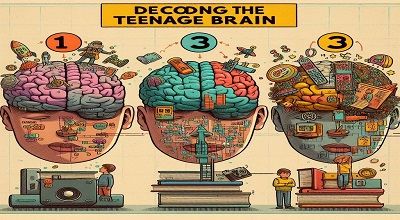Decoding the Teenage Brain
Decoding the Teenage Brain-compressed understanding of the teenage brain is a complex task. It undergoes significant changes during adolescence. While it’s not possible to fully encapsulate the complexity of the teenage brain in just three charts. Here are three simplified charts that highlight some key aspects of adolescent brain development:
Chart 1: Structural Brain Development
This chart illustrates how the brain’s structure changes during adolescence. With a focus on gray and white matter development. It shows that the volume of gray matter (which contains cell bodies and synapses) peaks during early adolescence and then starts to decline.
White matter (responsible for connecting different regions of the brain) continues to increase into early adulthood. This reflects the pruning of unused connections and the strengthening of important ones as the brain becomes more efficient.
luaCopy code
Structural Brain Development in Adolescence
-------------------------------------------------Gray Matter
│
│ Peak
│ │
│ │
│ │
│ │
│ │
│ │
│ │
│ │
└────────────────────┘─── Decline
Adolescence Early Adulthood
Chart 2: Prefrontal Cortex Development
This chart highlights the development of the prefrontal cortex, the region responsible for complex thinking, decision-making, and impulse control. It shows that this part of the brain undergoes significant changes during adolescence. with a prolonged period of maturation. The dotted line represents the ongoing development of the prefrontal cortex into early adulthood.
luaCopy code
Prefrontal Cortex Development in Adolescence
-------------------------------------------------Prefrontal Cortex
│
│ Maturation
│ │
│ │
│ │
│ │
│ │
│ │
└─────────────────────────┘─── Ongoing
Adolescence Early Adulthood
Chart 3: Emotional Regulation
This chart illustrates the balance between the emotional center of the brain (the limbic system). The prefrontal cortex is responsible for emotional regulation and impulse control. During adolescence, there is an imbalance, with the limbic system often dominating. Which can lead to increased emotional reactivity and risk-taking behavior. As the prefrontal cortex matures, emotional regulation improves.
scssCopy code
Emotional Regulation in the Teenage Brain
-------------------------------------------------Emotional
Center (Limbic System)
│
│ Imbalance
│
│
└───────────────────────── Balance
Adolescence Early Adulthood
│─ Risk-taking, emotional reactivity
│
└─ Improved impulse control, emotional regulation
Summary
These charts provide Decoding the Teenage Brain with a simplified overview of some aspects of teenage brain development. However, it’s essential to remember that individual differences and environmental factors can significantly influence. How these changes manifest in different adolescents. The teenage brain is a dynamic and complex system, and these charts serve. As a basic framework for understanding its development.
